“It only takes one person to bear witness. One to share what they have seen.” Animals Australia Facebook page
Once upon a time I worked for a tv show. One day my boss called me in to her office to see some footage. She had obtained it from Spain to be included in an episode of the show. It was a bullfight. Her name was Lyn Bayonas. She learned about the bullfight from her old boss, Orson Welles. Mr Welles was an aficionado, up there with Hemmingway with his passion for things Spanish. I had absolutely no interest; rather I felt revulsion for the ghoulish spectacle on the screen. Lyn insisted, as only she could, that I sit down and learn something. She explained the bullfight is a ritual. It’s about our relationship with nature. Our relationship to death. Our relationship to meat.
 Her lecture came back to me recently when I found a copy of Death and the Sun; A matador’s season in the heart of Spain by Edward Lewine. It’s a great read. A page-turner. Will the matador die in the bullring, like his father before him?
Her lecture came back to me recently when I found a copy of Death and the Sun; A matador’s season in the heart of Spain by Edward Lewine. It’s a great read. A page-turner. Will the matador die in the bullring, like his father before him?
There’s no doubt about the bulls, of course.
“Bulls suffer and die in the bullring. Either you believe this is justified, or balanced somehow by the supposed beauty, history, and cultural significance of the corrida, or you don’t. Cattle and other animals suffer and die in the food industry. Either you believe this is justified, or balanced somehow by the human desire for nourishment from meat and by the tradition of meat-eating, or you don’t.” pg 188
The Spanish don’t have a word for bullfighting, instead they use words such as, “the fiesta de los toros (festival of the bulls) or fiesta brava (wild festival) … What the matador (killer) ” … does with the bull is usually translated in English as “to fight” but the Spanish word for this is torear, which takes the word for bull and makes a verb out of it, “to bull”. The art or craft of bullfighting is called toreo — “bulling”.’ pg 25
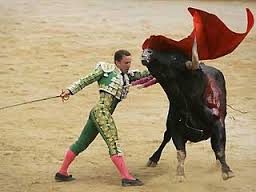
http://www.sodahead.com/fun/first-thing-you-think-of-when-you-think-of-spanish/question-1627465/?page=2
He explains that, ‘A single bullfight involving full-grown bulls is called a corrida de torros” … ‘The act of holding a corrida is indicated by the word celebrar, as in, “Yesterday they celebrated a corrida.’ pg 26. It’s like saying we celebrated mass or morning matins. It’s a ritual. It’s not a fight. The bull has no chance to live. The bull will die. The bull becomes meat. He represents all cattle, all meat. However, he does have a chance to take the matador out with him or at least give him a few weeks off and a decent scar to remember him by. Lewine again:
‘Bullfighting is easy to dismiss as an artefact of humanity’s savage and uncivilized history. But in its bloody way the bullfight is the essence of civilization, if by civilization we mean humanity’s subjugation of the natural world and the development of custom and ritual to replace violence as the governing principle of human interaction. A society that can mount a corrida is an advanced society, one that has tamed nature, met the basic needs of its people (to the extent that entertainment is a priority), and channeled the bloody impulses of its populace into ordered ritual. There is nothing more civilized than a bullfight. It is the sum of humankind’s fears and wordless needs contained in a spectacle of rigid control and elaborate ceremony.’ pg 227
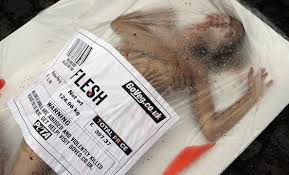 Think about it. It’s too easy now to pick up that shrink-wrapped flesh from the meat aisle and sizzle it into some processed sauce and slap it between two calcium enriched buns without giving a second thought to the life given. It’s too easy to ignore empathy as the cows are stripped of their skin and twitch in their chorus-line of death on the way to their disembowelling. No. We must turn the spotlight on our food. We must face up to our responsibility. You must look. You must see.
Think about it. It’s too easy now to pick up that shrink-wrapped flesh from the meat aisle and sizzle it into some processed sauce and slap it between two calcium enriched buns without giving a second thought to the life given. It’s too easy to ignore empathy as the cows are stripped of their skin and twitch in their chorus-line of death on the way to their disembowelling. No. We must turn the spotlight on our food. We must face up to our responsibility. You must look. You must see.
‘Aficionados say there is a special feeling that comes when a great matador passes a bull low and slow around his body and the bull responds, charging hard at the cape and lending solemnity and danger to the matador’s movements. Hemmingway described it as a lump in the throat. Garcia Lorca called it “man’s finest anger, his finest melancholy and his finest grief.” It is an electric mixture of fear, pleasure in beauty, sadness, anger, horror, joy, tension, the feeling of victory over death, and the viewer’s relief that he or she is safe and not facing the bull.’ pg 32
This is far more than a cat playing with a mouse. Lewine describes the matador’s use of a bull as the painter’s use of a brush or a trumpet player’s use of the trumpet. The man makes art with the vanquished beast. The man is an artist, seeking beauty in the subjugation of the other life. The art lies in the domination. The wildcard is the bull. It may toss, gore or kill. But it will die in its turn. Certainly.
Of course it’s cruel. Of course the bull suffers. Right in front of your eyes.
Hideous.
But
Honest.
Consider the conspiracy in modern farming. What is locked away behind hedges and walls? How many cows suffer every minute of every day in feedlots? How many pigs are shut up in sheds unable to move for their entire life? How many chickens were kicked to death in the last hour? All far, far away from the public gaze?
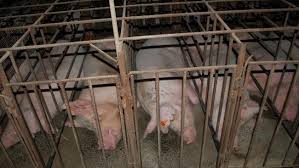
http://www.news.com.au/finance/coles-to-phase-out-sow-stall-pork-on-welfare-grounds/story-e6frfm1i-1225895345283
Today in most affluent countries, farming animals for meat is done out of sight. Billions of invisible creatures are bred and fed in close confinement and slaughtered on a conveyor belt. Their lives are lived in darkness, pain and terror. Humans peruse their hermetically sealed plastic packages of flesh without the faintest glimmer of awareness of how that beast lived and died to become a product. Now the agriculture industry seeks laws to protect their secrecy even further, laws known as ‘Ag Gags’ where it will be illegal for activists to visit and photograph factory or experimental farms or indeed any animal abuse. Sign a petition against them here.
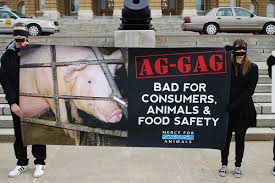
http://www.nationofchange.org/ag-gag-laws-criminalize-activists-exposing-cruel-factory-farm-practices-1382193266
This is the horror. That humans can have so little regard for life that they slaughter millions, nay, trillions of creatures (created by ?) to slice into pieces because they like the taste when it is no longer even necessary to eat meat. That the meat industry can seek protection to continue to devolve their systems is hideous. Dishonest. Deceitful.
If you see the bullfight as a ritual then this modern denial of death seems weak. We become insipid and deceptive, hiding, cowering from the facts of life. We watch hideous news every day, rubber-neck at bloody car crashes and see extreme violence surrounded by fumes from chemical-laden popcorn and rumbles of high-performance Dolby. Pretending. Playing.
That six bulls should die in an afternoon in the full glare of the sun, witnessed by people who are at least emotionally sensitive to their existence, seems just and fair.

http://carolineangusbaker.com/2013/06/21/a-little-jaunt-to-spain-review-part-6-bullfighting-in-spain-madrid-vs-valencia/
Bear witness to your meat.
Honourably.
Or, you know, you do have a choice …
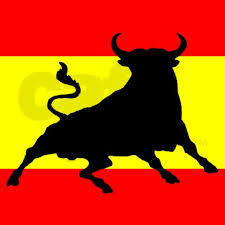
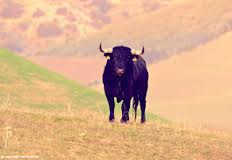

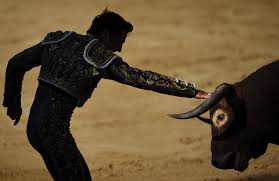
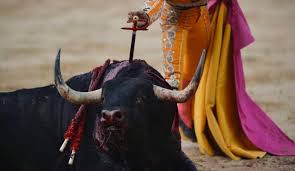
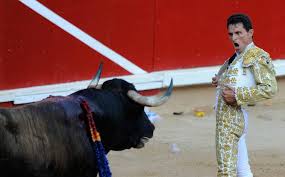

Recently I visited Canterbury in the UK. I enjoyed a walking tour which started at the Christian Gate, a medieval portal to the awesome Canterbury Cathedral. To our right, there was a pub called the Bull Baiting Inn. Our guide informed us that in the courtyard of the pub the public would torment bulls in all the imaginative ways that humans have done for hundreds of years. Using dogs, pitchforks and human ingenuity they prodded, poked and punched the poor beasts until the butchers deemed them ready. For the butcher would not kill the bull unless it had been tortured. They believed it made the meat more tender.
Oh Vic, here is a great breakdown of the way we human animals ritualise and romanticise the act of killing another animal to mask our inherent discomfort at this unnatural act.
Coleen Patrick-Goudreau is one of my all time favourite vegan educators. I lament the fact that I had not discovered her while my parents were still around. It would have made our relationship so much smoother as I learned hoy to be a happy vegan.
I particularly love the part where she points out how no child ever had to be comforted or told white lies to ease the sadness and horror of eating vegetables!!!!!
It was a great read, and I really do appreciate your point. I find it inconceivable idea that rational people who consider themselves compassionate would turn their backs so completely on the suffering of all those billions of lives. The damaging repercussions within our group psyche will be dark and deep.
This is a beautifully writen article. Clearly inspired by Lewines rapturous description of the spectacular ritual torture and abuse of a proud and powerful animal. Nicely juxtaposed against the wholesale banality of industrialised abuse of trillions of individual animals for an equally unnecessary purpose.
However I have to intensely disagree that there is anything actually honourable about the bullfighting phenomena. To my understanding it varies only slightly in degree from the canned hunting so popular in Africa these days.
Lewine has indeed painted a very seductive picture of the honourable ideal of bullfighting; man facing beast alone in an arena etc etc, and as someone who has never attended one I have to defer to other writers for a balancing of that perspective.But he does appear to be glossing over all the ugly truths.
I found Jeffrey Masson’s book ‘Beast’ to be a far more objective account of the unfair goading and crippling of the bulls in the ring. Done purely to ensure the humans who stood before them had the upper hand. The bulls are unnaturally roused to anger by various means, all of them abusive, and that abuse is ramped up throughout the fight to ensure a ‘good show’ as the bull would generally give up, being naturally willing to concede in most cases to avoid more pain. Then at the same time the poor animal is handicapped with drugs and other means to give the human a better chance. Only if the the bull is strong enough to overcome all of these trials is there the remotest chance he will turn with focus and intent in a likely futile attempt to finish his tormentor.
This said, your broader point remains true and clear. The final hours of these few pitiful young bulls were at least born witness to by a crowd. Without a doubt the thousands of animal lives those same audience members consume afterward warrant no more thought than the ants they trod on walking to the car. Yet the effect on the human psyche of that denial is a wound unplumbed, and the effect on our environment the production of these animals is having threatens to be be the death of our civilisation if it continues to increase at its current rate.
This was the point you made beautifully.
We all have a choice to make where animals are concerned. We can choose to remain in ignorance of any meats’ true cost, or we can open our eyes, hearts and minds to the reality, and at the table, choose differently.
Thank you, Jenny, for your considered (flattering!) remarks. To be fair to Lewine he doesn’t gloss over the cruelty faced by bulls. On page 188 he says, ‘… bulls exhibit clear signs of suffering in the ring. They shake their heads, they bellow, they cough and sputter and weave around. They also seem to be in some kind of emotional anguish …’ He does describe in great detail how the bulls are reared and tested for the corridas. And it’s fucked. But so be it. If people want to eat meat, they should watch it all as close up as they can get. They should acknowledge it. It must be brought out into the open. I don’t think many people think about how their food is grown and as for Senator Chris Beck and others supporting proposed laws which would prevent activists giving footage of possible cruelty to media, well. I don’t think many people would want to kill their own dinner much less watch a bullfight which is why we have this hidden culture of ‘food production’. But how many people really consider how MANY animals die every day? Farming ‘aint done the old way anymore!